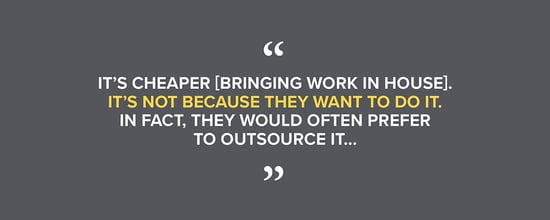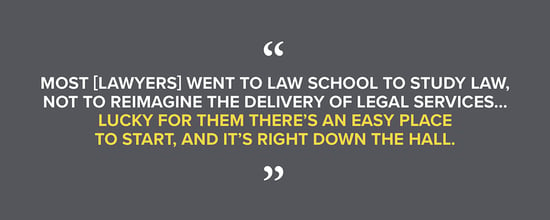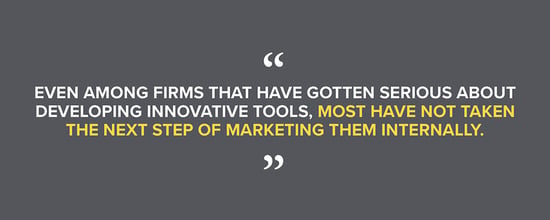This is part three of a six-part email miniseries expanding on Baretz+Brunelle’s Where Will the Work Go? futurecast. If you have time to watch the whole thing, catch the video replay here. If you don’t, this Q&A with presenter Brad Blickstein is a 4-minute read.
The B+B New Law Team can help you identify opportunities throughout your firm and build the kinds of legal service delivery models that clients are looking for.
If anyone is qualified to deliver a “futurecast” on the relationship between law firms and the corporate legal departments they serve, it’s Brad Blickstein. That’s because he knows the history of that relationship so well. In the early 1990s, Brad helped launch Corporate Legal Times (now InsideCounsel), one of the first information sources designed specifically for in-house counsel. He has been particularly influential in the rise of the legal operations function within legal departments over the last 25 years. In 2008, before many law departments had any legal operations personnel, he began conducting his Annual Law Department Operations Survey, which remains the authoritative survey on the subject.
Brad sat down for a dialogue with John Ford, a former practitioner at an Am Law 100 firm and partner at Baretz+Brunelle, where Brad now leads the NewLaw practice.
JF: You’ve spent much of your career as an evangelist for in-house legal departments, often urging them to grow at the expense of law firms. Is it difficult to square that with your role at Baretz+Brunelle advising law firms, and specifically with the message of the futurecast?
BB: Guilty as charged. After 25 years of studying law department operations in depth, I’ve made a shift to advising law firms as co-head of B+B’s NewLaw practice. But they are both players in the same ecosystem.
My fundamental message hasn’t changed, either. As I note in the futurecast, there’s a single reason why legal departments have clawed so much work back from law firms over the last 25 years (and why I’ve encouraged them to do it): It’s cheaper that way. It’s not because they want to do it. In fact, they would often prefer to outsource it, like businesses have done with all other non-core functions besides legal. The challenge for law firms is to create efficiencies in their service that allow legal departments to justify sending the work out. As the futurecast explains, this is the perfect time to do that.

JF: What did we learn from the Great Recession that’s relevant to the present recession? Are any impacts from 2008 still with us today?
BB: Oh, very much so. The Great Recession chipped away at some long-held assumptions about how corporate clients should buy legal services. I’m thinking of one in particular that will never be as strong again. Before 2008, general counsel enjoyed what I call a “cloak of immunity” when it came to selecting outside counsel. On any particular matter, they could insist that given the risk it presented, they simply had to go with the GC’s preferred law firm. The business people did not feel competent to question such a choice.
The recession shifted things. As cost saving became a corporate imperative at least as important as risk avoidance, the cloak of immunity around those decisions began to wear thin. The economy rebounded after 2008, but the degree of deference given to GCs never quite did. In fact, buying decisions have become increasingly professionalized. This downturn will only accelerate that continuing trend.
JF: What practical steps can a law firm partner take today to put the ideas from your futurecast into action?
BB: I’m glad you asked this. It’s a question that might trouble a lot of lawyers – and rightly so. Most went to law school to study law, not to reimagine the delivery of legal services. A partner at an Am Law 200 firm today could have gone their entire career without seriously questioning how their firm does business. It’s understandable that they might feel unequipped to change that. Or that when asked to innovate, they might get paralyzed before they even start. Lucky for them there’s an easy place to start, and it’s right down the hall.

I ended my presentation with a call to action for law firms. I encouraged them to adopt innovations that clients want, and that alternative legal services providers have excelled at delivering: creative pricing, improved project management, better use of technology, and client-facing digital services. It's true that most partners at Am Law 200 firms haven’t thought about those issues, but it’s also true that small groups within many of those firms have. So I recommend that lawyers look inside their firms to find these pockets of innovation.
JF: Wouldn’t a lawyer already know about new service offerings at their own firms?
BB: Not necessarily. Even among firms that have gotten serious about developing innovative tools, either at the firm itself or a captive ALSP, most have not taken the next step of marketing them internally. A firm could have created a valuable contract management service that many of its partners aren’t aware of yet. Or it might have an innovation team that’s about to roll out a product that the partnership has never heard about. As I’ve come to learn, these scenarios are very possible.

JF: And if there are no helpful tools being built down the hall?
BB: That’s when they can consider building one themselves. But even then, they don’t have to get their hands too dirty. There are technophiles and people responsible for process improvement at most firms. Of course, Baretz+Brunelle is happy to help as well.

